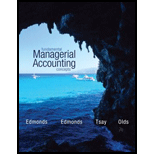
a.
Calculate the profit margin of Corporation S.
a.
Explanation of Solution
Operating profit margin: This ratio gauges the operating profitability by quantifying the amount of income earned from business operations from the sales generated.
Formula of operating profit margin:
Calculate the profit margin of Corporation S, if operating income is $16,000 and sales is $320,000.
Thus, the profit margin of Corporation S is 5%.
b.
Calculate the turnover of Corporation S.
b.
Explanation of Solution
Investment turnover: This ratio gauges the operating efficiency by quantifying the amount of sales generated from the assets invested.
Formula of investment turnover:
Calculate the turnover of Corporation S, if operating assets is $200,000 and sales is $320,000.
Thus, the turnover of Corporation S is 1.6 times.
c.
Calculate the
c.
Explanation of Solution
Calculate the ROI of Corporation S, if operating income is $16,000, and operating assets are $200,000.
Thus, the ROI of Corporation S is 8%.
d-1.
Calculate the ROI of Corporation S, if operating income increases to $18,000, and sales increases to $360,000.
d-1.
Explanation of Solution
Formula of ROI according to DuPont formula:
Calculate the ROI of Corporation S, if operating income increases to $18,000, sales increases to $360,000, and operating assets remain at $200,000.
Thus, ROI of Corporation S is 9%.
2.
Calculate the ROI of Corporation S, if operating income increases to $16,800.
2.
Explanation of Solution
Calculate the ROI of Corporation S, if operating income increases to $16,800, sales remain at $320,000, and operating assets remain at $200,000.
Thus, ROI of Corporation S is 8.4%.
3.
Calculate the ROI of Corporation S, if operating assets decreases to $160,000.
3.
Explanation of Solution
Calculate the ROI of Corporation S, if operating assets decreases to $160,000, sales remain at $320,000, and operating income remains at $16,000.
Thus, ROI of Corporation S is 10%.
Want to see more full solutions like this?
Chapter 9 Solutions
Fundamental Managerial Accounting Concepts with Access
- Cooper Industries disposed of an asset at the end of the sixth year of its estimated life for $12,500 cash. The asset's life was originally estimated to be 8 years. The original cost was $76,000 with an estimated residual value of $6,000. The asset was being depreciated using the straight-line method. What was the gain or loss on the disposal? Helparrow_forwardCooper Industries disposed of an asset at the end of the sixth year of its estimated life for $12,500 cash. The asset's life was originally estimated to be 8 years. The original cost was $76,000 with an estimated residual value of $6,000. The asset was being depreciated using the straight-line method. What was the gain or loss on the disposal?arrow_forwardI need guidance with this general accounting problem using the right accounting principles.arrow_forward

 AccountingAccountingISBN:9781337272094Author:WARREN, Carl S., Reeve, James M., Duchac, Jonathan E.Publisher:Cengage Learning,
AccountingAccountingISBN:9781337272094Author:WARREN, Carl S., Reeve, James M., Duchac, Jonathan E.Publisher:Cengage Learning, Accounting Information SystemsAccountingISBN:9781337619202Author:Hall, James A.Publisher:Cengage Learning,
Accounting Information SystemsAccountingISBN:9781337619202Author:Hall, James A.Publisher:Cengage Learning, Horngren's Cost Accounting: A Managerial Emphasis...AccountingISBN:9780134475585Author:Srikant M. Datar, Madhav V. RajanPublisher:PEARSON
Horngren's Cost Accounting: A Managerial Emphasis...AccountingISBN:9780134475585Author:Srikant M. Datar, Madhav V. RajanPublisher:PEARSON Intermediate AccountingAccountingISBN:9781259722660Author:J. David Spiceland, Mark W. Nelson, Wayne M ThomasPublisher:McGraw-Hill Education
Intermediate AccountingAccountingISBN:9781259722660Author:J. David Spiceland, Mark W. Nelson, Wayne M ThomasPublisher:McGraw-Hill Education Financial and Managerial AccountingAccountingISBN:9781259726705Author:John J Wild, Ken W. Shaw, Barbara Chiappetta Fundamental Accounting PrinciplesPublisher:McGraw-Hill Education
Financial and Managerial AccountingAccountingISBN:9781259726705Author:John J Wild, Ken W. Shaw, Barbara Chiappetta Fundamental Accounting PrinciplesPublisher:McGraw-Hill Education





